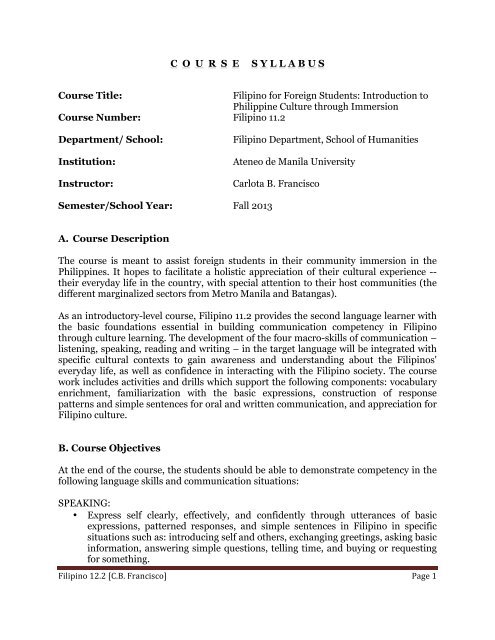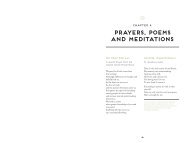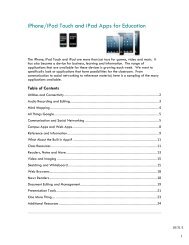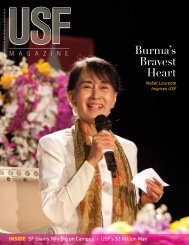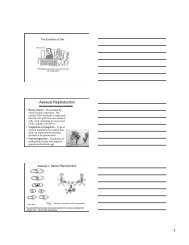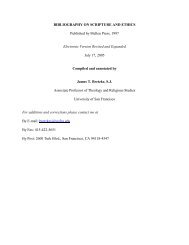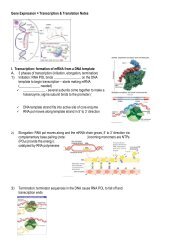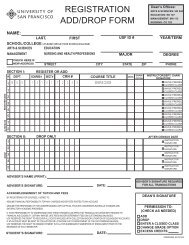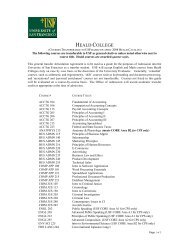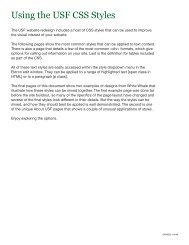Download Syllabus - University of San Francisco
Download Syllabus - University of San Francisco
Download Syllabus - University of San Francisco
Create successful ePaper yourself
Turn your PDF publications into a flip-book with our unique Google optimized e-Paper software.
C O U R S E S Y L L A B U S<br />
Course Title: Filipino for Foreign Students: Introduction to<br />
Philippine Culture through Immersion<br />
Course Number: Filipino 11.2<br />
Department/ School: Filipino Department, School <strong>of</strong> Humanities<br />
Institution: Ateneo de Manila <strong>University</strong><br />
Instructor: Carlota B. <strong>Francisco</strong><br />
Semester/School Year: Fall 2013<br />
A. Course Description<br />
The course is meant to assist foreign students in their community immersion in the<br />
Philippines. It hopes to facilitate a holistic appreciation <strong>of</strong> their cultural experience -their<br />
everyday life in the country, with special attention to their host communities (the<br />
different marginalized sectors from Metro Manila and Batangas).<br />
As an introductory-level course, Filipino 11.2 provides the second language learner with<br />
the basic foundations essential in building communication competency in Filipino<br />
through culture learning. The development <strong>of</strong> the four macro-skills <strong>of</strong> communication –<br />
listening, speaking, reading and writing – in the target language will be integrated with<br />
specific cultural contexts to gain awareness and understanding about the Filipinos'<br />
everyday life, as well as confidence in interacting with the Filipino society. The course<br />
work includes activities and drills which support the following components: vocabulary<br />
enrichment, familiarization with the basic expressions, construction <strong>of</strong> response<br />
patterns and simple sentences for oral and written communication, and appreciation for<br />
Filipino culture.<br />
B. Course Objectives<br />
At the end <strong>of</strong> the course, the students should be able to demonstrate competency in the<br />
following language skills and communication situations:<br />
SPEAKING:<br />
• Express self clearly, effectively, and confidently through utterances <strong>of</strong> basic<br />
expressions, patterned responses, and simple sentences in Filipino in specific<br />
situations such as: introducing self and others, exchanging greetings, asking basic<br />
information, answering simple questions, telling time, and buying or requesting<br />
for something.<br />
Filipino 12.2 [C.B. <strong>Francisco</strong>] Page 1
This can be measured through classroom discussions, dialogues, short skits/role<br />
play, interviews and conversing with the locals, as well as in the presentations<br />
<strong>of</strong> the interviews and sharing <strong>of</strong> experiences.<br />
LISTENING:<br />
• Understand and respond to sentence-length utterances given in specific contexts<br />
such as sharing information about self, reacting to spoken expressions which<br />
reveal emotions, and following simple instructions.<br />
• Recognize the meaning <strong>of</strong> a spoken Filipino word/expression as guided by an<br />
applied stress and intonation.<br />
Within classroom setting, these can be measured through discussions and<br />
recitations, dialogues/short skits/role play, and other oral exercises which<br />
involve listening to music, watching video clips, and films, etc.<br />
Within community settings, these can be measured through conversing with the<br />
locals and doing interviews on field trips which the students need to<br />
report/present/share during classroom discussions.<br />
READING:<br />
• Recognize a number <strong>of</strong> vocabulary items and signs which appear in materials in<br />
Filipino such as local songs, menus, public signs, tabloids, etc.<br />
• Understand simple written instructions and deliver appropriate responses.<br />
• Develop skills in comprehending short written texts in Filipino like simple<br />
dialogues and sample communication situations in specific cultural contexts.<br />
These can be measured through seat works, quizzes, projects and class<br />
presentations.<br />
WRITING:<br />
• Respond to basic writing needs such as filling out forms about personal<br />
information, expressing short messages on different occasions celebrated in<br />
Filipino context, making a list <strong>of</strong> ingredients for a particular Filipino dish, etc.<br />
This can be measured through seat works, quizzes, exam, and projects.<br />
CULTURE:<br />
• Identify objects and practices which are associated to Filipino identity and<br />
traditions (e.g. naming the national symbols <strong>of</strong> the Philippines, being familiar<br />
with some local celebrations or holidays, etc.).<br />
Filipino 12.2 [C.B. <strong>Francisco</strong>] Page 2
• Know the different values <strong>of</strong> the Filipinos which are connected to their language<br />
and manners in communicating (e.g. words and gestures which show respect).<br />
• Appreciate the Filipino culture through various activities outside the classroom.<br />
These can be measured through class discussions, in role plays, especially<br />
during sharing <strong>of</strong> experiences, reporting <strong>of</strong> interviews, the exam and project.<br />
C. Course Outline and Timeframe<br />
Week Topic<br />
Orientation<br />
(2 nd wk. <strong>of</strong><br />
Aug.)<br />
1<br />
(3 rd wk. <strong>of</strong><br />
Aug.)<br />
Course Introduction<br />
The course outline<br />
The course requirements<br />
The Grading system<br />
Assignment:<br />
1. Take a jeepney ride and observe the facade and interior <strong>of</strong> a<br />
jeepney.<br />
• Take note <strong>of</strong> any detail that catches your attention. Observe as<br />
well the interactions among the passengers, and between<br />
passengers and the driver.<br />
2. Read: Hornedo, F. H. “The Visitor and the Native in the Jeepney<br />
and the Tricycle.” Pagmamahal and Pagmumura. 1997: 109-114.<br />
“Sakay Na!”<br />
Session 1: A Brief Jeepney Ride through Filipino Culture and<br />
Personhood<br />
A Crash Course on Riding a Jeepney<br />
A glimpse at Filipino Culture, Personhood and Values, Pop Art and<br />
Concept <strong>of</strong> Space.<br />
Session 2: Language Exercises on:<br />
Jeepney Scenes…<br />
Simple Introductions…<br />
Song: “Limang Dipang Tao” by Ryan Cayabyab<br />
Assignment: Pagpapakilala<br />
Prepare a short introduction <strong>of</strong> yourself keeping in mind the<br />
Filipino 12.2 [C.B. <strong>Francisco</strong>] Page 3
2<br />
(4 th wk <strong>of</strong><br />
Aug.)<br />
3<br />
(1 st wk. <strong>of</strong><br />
Sept.)<br />
usual content <strong>of</strong> a typical self introduction in any social context<br />
within your cultural setting.<br />
Reading:<br />
Hornedo, F. H. “The Visitor and the Native in the Jeepney and<br />
the Tricycle.” Pagmamahal and Pagmumura. 1997: 109-114.<br />
Ako Si… --What’s in the Filipino Name<br />
Session 1: The Art and Cultural Context <strong>of</strong> Pagpapakilala<br />
Introducing Self and Getting to Know Others<br />
Basic Greetings, Responses and Gestures<br />
Exercises/drills<br />
Session 2: A Brief History on the Filipino Language<br />
Speaking the Filipino Language: Filipino Alphabet and Phonemes<br />
Song: “ABaKaDa” by Florante<br />
Cultural Experience: Savoring Halu-halo: A Taste <strong>of</strong> Filipino Language<br />
and Culture<br />
Readings:<br />
Barrios, J. “Pagpapakilala.” Tagalog for Beginners. 2011:1-14.<br />
_______. “Pagbati.” Tagalog for Beginners. 2011:14-25.<br />
_______. “Why Filipino and Not Pilipino: A Brief History <strong>of</strong><br />
Making a Language a National Language. Tagalog for<br />
Beginners. 2011:357-358.<br />
The Filipino Personhood – <strong>of</strong> Kapwa and the Self<br />
Session 1: Ang Pagkataong Pilipino<br />
An Introduction to the Filipino Pronouns (Panghalip) with<br />
special attention to “kita”.<br />
Workshop…<br />
Session 2: Bridging Indifference from the Ibang Tao to Di-Ibang Tao<br />
Establishing Relationship with Filipinos<br />
Language Strategy: Using Po and Opo, Ate/Manang,<br />
Kuya/Manong, etc.<br />
Exercises/drills…<br />
Filipino 12.2 [C.B. <strong>Francisco</strong>] Page 4
4<br />
(2 nd wk <strong>of</strong><br />
Sept.)<br />
Readings:<br />
De Guia, K. “Ang Pagkataong Filipino: A Theory <strong>of</strong> Filipino<br />
Personhood.” Kapwa: The Self in the Other. 2005: 17-44<br />
Enriquez, V. G. “Shared Inner Self.” From Colonial to Liberation<br />
Psychology: The Philippine Experience. 2008: 52-56.<br />
Pe-pau, R. and E. Protacio-Marcelino. “Sikolohiyang Filipino (Filipino<br />
Psycchology): A Legacy Of Virgilio G. Enriquez.” Asian Journal <strong>of</strong><br />
Social Psychology. 3(2000): 49-71<br />
Tao po! : Visiting a Friend’s House<br />
Session 1:From Bahay Kubo to Bahay na Bato –A Tour Within<br />
Filipino Homes<br />
Songs: Bahay Kubo (folksong)/Sa Aking Kubo and Bahay by Gary<br />
Granada<br />
Session 2: The Filipino Hospitality: Accepting and Refusing Politely<br />
an Invitation to Eat<br />
Language Strategy: Using the Prefix “Paki”, “Maki/Makiki”, Naki<br />
and Nakiki<br />
Exercises/drills…<br />
Readings:<br />
Barrios, J. “Ang bahay kubo and the bahay na bato”. Tagalog for<br />
Beginners. 2011:90<br />
_______. “Pagbisita sa Bahay ng Kaibigan”. Tagalog for<br />
Beginners. 2011: 42-51.<br />
______. “Ang Aming Bahay ”. Tagalog for Beginners. 2011:84-<br />
92 .<br />
Gardner, R. From Bahay Kubo to Bahay na Bato. Philippine<br />
Journeys. http://www.aenet.org/photos/bahay.htm<br />
Noche, M. History <strong>of</strong> Philippine Architecture. NCCA.<br />
http://www.ncca.gov.ph/about-culture-and-arts/articles-on-c-na/article.php?igm=1&i=110<br />
Assignment:<br />
Make a family tree <strong>of</strong> your host family or a family in your praxis<br />
site.<br />
Mano po: An Introduction to the Filipino Family<br />
Session 1: The Filipino Mag-anak, Kamag-anak, and Ritual Kinship.<br />
Relationship Words and the Prefix “Ka”<br />
Filipino 12.2 [C.B. <strong>Francisco</strong>] Page 5
5<br />
(3 rd wk. <strong>of</strong><br />
Sept.)<br />
6<br />
(4th wk. <strong>of</strong><br />
Sept./<br />
Calatagan<br />
immersion<br />
wk.)<br />
Workshop on the assignment<br />
Session 2: Anak –The Filipino Child<br />
Pagtuturo at Disiplina: Disciplining the Filipino Way (Pananakot,<br />
Kapangyarihan and Pagmamahal)<br />
Tips on dealing with children in your praxis community (e.g.<br />
teaching the children to count, know the parts <strong>of</strong> the body, simple<br />
arithmetic and tell the time and date)<br />
Song:<br />
Anak by Freddie Aguilar<br />
Paa, Tuhod, Balikat, Ulo (Children’s song)<br />
Lubi-lubi by Yoyoy Villame<br />
Home work/Assignment: Watch the movie, Anak and answer the<br />
guide questions<br />
Readings:<br />
Barrios, J. “Ang Aking Pamilya”. Tagalog for Beginners. 2011: 73-<br />
83.<br />
Medina, B. T.G. “Issues Relating to Filipino Marriage and Family.<br />
Social Science Information. 23: 1-2(1995): 36-43.<br />
Torres, A. "Rethinking the Filipino Family: Tracking Changes<br />
Across the Years.” Social Science Information. 23:1-2(1995): 54-<br />
66.<br />
Ang Nayon at Mga Taga-nayon<br />
Session 1: Ang Nayon at mga Taga-nayon: Prelude to Entering A<br />
Fishing (Calatagan Community Immersion)<br />
The prefix “Taga” and the suffix “an”<br />
Introduction to Calatagan Batangas<br />
Video clips:<br />
Calatagan Hymn.<br />
http://www.youtube.com/watch?v=YP4aMQDO5hk<br />
International Collective In Support <strong>of</strong> the Fisherworkers (ICSF):<br />
The Fisher Folks <strong>of</strong> Calatagan.<br />
http://www.youtube.com/watch?v=qzobFjtEEXE<br />
Seaweeds Farming in Calatagan.<br />
http://www.youtube.com/watch?v=aQt8iu5-oA<br />
Filipino 12.2 [C.B. <strong>Francisco</strong>] Page 6
7<br />
(1st wk. <strong>of</strong><br />
Oct.)<br />
8<br />
(2 nd wk. <strong>of</strong><br />
Oct./ before<br />
the fall break)<br />
Session 2: Understanding the Dynamics <strong>of</strong> Bayanihan and Damayan<br />
From civility (pakikilahok) to Being One (Pakikiisa) with the<br />
community.<br />
o Culture notes on Attending Birthdays, Weddings and Wakes.<br />
o Helping with household chores.<br />
o Eating, sleeping, taking baths, etc.<br />
Song: “Bayanihan sa Bayan ni Juan” by Mike Hanapol<br />
Reading:<br />
Barrios, J. Plazaz, the taga-bukid and the taga-bayan. Tagalog for<br />
Beginners. 2011: 98-99.<br />
Assignment:<br />
Prepare a community pr<strong>of</strong>ile based on the experience you had in<br />
Calatagan. The assignment should demonstrate your observation <strong>of</strong><br />
the neighborhood and participation, as well as reflection on the<br />
community’s everyday life.<br />
Revisiting the Calatagan Experience within the Sikolohiyang<br />
Filipino (Kapwa) Framework<br />
Session 1: Pagbabahagi at Pagpoproseso ng Karanasan<br />
Presentation <strong>of</strong> the assignment on Calatagan (Sharing).<br />
Session 2: The taga-bayan and taga-nayon (bukid/bundok)<br />
Dichotomy<br />
A glimpse <strong>of</strong> the culture divide.<br />
Exercises/drills…<br />
Orientation on the next meeting’s activity (“A taste <strong>of</strong> street life”)<br />
Tayo Na’t Maglakbay<br />
Session 1: Tara na’t Mag-ikot!: A Taste <strong>of</strong> Street Life<br />
Pag-iikot at paggagala – A direct encounter with Filipino Street<br />
Characters, Food and Culture.<br />
Session 2: Maglibot Tayo!<br />
Paglalakbay: From Luzon to Mindanao<br />
Tips on travelling<br />
Cultural Experience: A taste <strong>of</strong> Street food<br />
*Submission <strong>of</strong> the Project Proposal*<br />
Filipino 12.2 [C.B. <strong>Francisco</strong>] Page 7
9<br />
(4th wk.,<br />
Oct./<br />
After the fall<br />
break)<br />
10<br />
(5 th wk. <strong>of</strong><br />
Oct.)<br />
11<br />
(1 st wk <strong>of</strong><br />
Nov.)<br />
Mapping Structures and People in a typical Filipino Community<br />
Activities:<br />
Class visit with a nearby barangay (Krus na Ligas)<br />
Conversing with the locals (Pakikipagkuwentuhan)<br />
Assignment:<br />
Make a community pr<strong>of</strong>ile <strong>of</strong> the barangay you have visited taking<br />
note <strong>of</strong> the structures you have seen and the people you interacted<br />
with.<br />
Undas at a Glance<br />
Session 1: Undas [All Saints and Souls Day] at a Glance<br />
Pangangaluluwa and Undas Observance: Honoring and<br />
Remembering the Dead<br />
Afterlife and the Indigenous Concept <strong>of</strong> Soul (Kaluluwa)<br />
Session 2: Oras-oras, Araw-araw, Pana-panahon<br />
Describing the Weather<br />
On Telling Time: Filipino Expressions About Time<br />
Telling the Date<br />
Exercises/drills<br />
Readings:<br />
Abrera, M.B. L. The Soul Boat and the Boat Soul: An Inquiry into the<br />
Indigenous Soul. <strong>University</strong> <strong>of</strong> the Philippines: Department <strong>of</strong> History.<br />
http://www.researchsea.com/html/download.php/id/71/research/<br />
Chua, M.C. B. The Manunggal Jar as a Vessel <strong>of</strong> Hisstory. Artes de Las<br />
Pilipinas.<br />
http://www.artesdelasfilipinas.com/archives/50/the-‐manunggul-‐jar-‐as-‐a-‐ vessel-‐<br />
<strong>of</strong>-‐history<br />
Understanding the Filipino Spirituality within the KAPWA<br />
Psychology (Part 1)<br />
Session 2: Revisiting Superstitious Beliefs<br />
Kasal<br />
Pagbubuntis at Panganganak<br />
Lamay at Libing<br />
Exercises/drills/role play<br />
Film: Dead na Si Lolo. Topacio, S.<br />
Filipino 12.2 [C.B. <strong>Francisco</strong>] Page 8
12<br />
(2 nd week <strong>of</strong><br />
Nov.)<br />
13<br />
(3 rd wk. <strong>of</strong><br />
Nov.)<br />
14<br />
(4 th wk. <strong>of</strong><br />
Nov.)<br />
15<br />
Assignment: Watch the film, Ded na Si Lolo and answer the guide<br />
questions.<br />
Understanding the Filipino Spirituality within the KAPWA<br />
Psychology (Part 2)<br />
Session 3: Re-evaluating the Culture <strong>of</strong> Sufferings<br />
Kuwaresma<br />
Pasyon<br />
Penitensiya<br />
Exercises/drills/role play<br />
Film: Himala<br />
Assignment: Watch the film, Himala and answer the guide questions.<br />
Maligayang Pasko!<br />
Session 1: Paskong Pilipino: ways <strong>of</strong> celebrating Christmas in<br />
Philippines<br />
Simbang Gabi<br />
Monita, Monito<br />
Karoling<br />
Panunuluyan<br />
Song: “Paskong Pinoy Medley”<br />
Session 2: Kain Tayo! –Salu-salo: The Philippine Food Culture<br />
Everyday Food and Foods for Special Occasions<br />
Terms about food and cooking<br />
Describing Tastes<br />
Expressing satisfaction : Use <strong>of</strong> “Gusto” at “Ayaw”;<br />
Reading:<br />
Fernandez, D. G. “Culture Ingested: Notes on the<br />
Indigenization <strong>of</strong> Philippine Food.” Gastronomica –The Journal <strong>of</strong><br />
Food and Culture. 3.3(2003): 58-71.<br />
Project Presentation<br />
Final Exam<br />
Filipino 12.2 [C.B. <strong>Francisco</strong>] Page 9
D. References:<br />
Abrera, M.B. L. The Soul Boat and the Boat Soul: An Inquiry into the Indigenous Soul.<br />
<strong>University</strong> <strong>of</strong> the Philippines: Department <strong>of</strong> History.<br />
http://www.researchsea.com/html/download.php/id/71/research/<br />
Alejo, A. E. Tao Po! Tuloy! Quezon City: Office <strong>of</strong> Research and Publication. 1990<br />
Barrios, J. Tagalog for Beginners: An Introduction to Filipino, the National Language<br />
<strong>of</strong> the Philippines. Tokyo, Vermont, Singapore: Tuttle Publishing, 2011.<br />
Bellen, M. T.G. The Filipino Family. Quezon City: <strong>University</strong> <strong>of</strong> the Philippine Press.<br />
2001.<br />
___________. “Issues Relating to Filipino Marriage and Family”. Social Science<br />
Information. 23:1-2(1995): 36-43.<br />
Carlos, V. P. I'd Like to Speak Filipino I. Rev. ed. Manila: Victoria P. Carlos Publishing,<br />
2009.<br />
Castle, C. S. and L. Mcgonnel. Teach Yourself Tagalog. London: Hodder Education,<br />
2003.<br />
Chua, M.C. B. The Manunggal Jar as a Vessel <strong>of</strong> Hisstory. Artes de Las Pilipinas.<br />
http://www.artesdelasfilipinas.com/archives/50/the-manunggul-jar-as-a-<br />
vessel- <strong>of</strong>-history<br />
De Guia, K. Indigenous Filipino Values: A Foundation for a Culture <strong>of</strong> Non-Violence. 8<br />
Aug. 2012<br />
<br />
_________. Kapwa: The Self in the Other. Pasig: Anvil Publishing Inc., 2005.<br />
Enriquez, V. G. From Colonial to Liberation Psychology: The Philippine Experience.<br />
Quezon City: <strong>University</strong> <strong>of</strong> the Philippines Press, 2008.<br />
______________. “ Pilipino’y Maaaring Kilanlin sa Pamamagitan ng Kanyng<br />
Pagkain.” Likha. Ed. Benilda S. <strong>San</strong>tos. Quezon City: Office <strong>of</strong> Research and<br />
Publications. 2002: 117-127.<br />
Gardner, R. From Bahay Kubo to Bahay na Bato. Philippine Journeys.<br />
http://www.aenet.org/photos/bahay.htm<br />
Go, S. “The Filipino Family: Contemporary Issues and Research Prospects.” Social<br />
Science Information. 23:1-2(1995): 13-16.<br />
Filipino 12.2 [C.B. <strong>Francisco</strong>] Page 10
Hornedo, F. H. Pagmamahal and Pagmumura. Quezon City: Office <strong>of</strong> Research and<br />
Publications, 1997. Pp. 109-114.<br />
Noche, M. History <strong>of</strong> Philippine Architecture. NCCA. http://www.ncca.gov.ph/about-<br />
culture-and-arts/articles-on-c-n-a/article.php?igm=1&i=110<br />
Ramos, T. V. Conversational Tagalog. Manila: Merriam & Webster Bookstore, Inc.,<br />
under arrangement with <strong>University</strong> <strong>of</strong> Hawaii Press, Honolulu, Hawaii, U.S.A,<br />
1985.<br />
<strong>San</strong>tos, V. C. at L.E. <strong>San</strong>tos. New Vicassan's English-Pilipino Dictionary. Pasig City:<br />
Anvil Publishing Inc., 1995.<br />
Tan, A. “Four Meanings <strong>of</strong> Fatherhood”. Social Science Information. 23:1-2(1995):<br />
44:53.<br />
E. Course Requirements and Grading System<br />
Activities Value<br />
Written and oral exercises, quizzes, recitation,<br />
and workshops (role play/presentations)<br />
20%<br />
Assignments and Assignment Presentations 20%<br />
Project and Project Presentation 30%<br />
Final Examination 30%<br />
Total 100%<br />
Grading System<br />
A 92-100<br />
B+ 87-91<br />
B 84-86<br />
C+ 79-83<br />
C 75-78<br />
D 70-74<br />
F 69 and below<br />
F. Classroom Policies:<br />
1. Classes will start on time. Any student who will show up 15 minutes later than the<br />
supposed start <strong>of</strong> class will be considered late.<br />
Filipino 12.2 [C.B. <strong>Francisco</strong>] Page 11
2. If the number <strong>of</strong> cuts goes beyond the limit (3 cuts), the student gets a<br />
WITHDRAWN status. Students are responsible for any missed lessons, activities,<br />
or tests.<br />
3. All requirements must be submitted on time.<br />
4. Students should aid in maintaining a conducive place for learning. Gadgets<br />
(laptops, electronic tablets, etc.) are not allowed to be used during class hours<br />
except for presentation purposes. The same policy applies for the use <strong>of</strong> cell<br />
phones, especially when taking tests.<br />
5. Active participation is expected in class since the nature <strong>of</strong> the course requires it.<br />
6. Apart from the above policies, academic dishonesty in all forms will not be<br />
tolerated and will be dealt with in accordance to the Ateneo de Manila Loyola<br />
Schools’ Code <strong>of</strong> Academic Integrity. Read the Loyola School’s Student Guide to<br />
the Code <strong>of</strong> Academic Integrity for a detailed discussion.<br />
CARLOTA B. FRANCISCO<br />
Kagawaran ng Filipino, 3 rd Flr. Dela Costa Bldng.<br />
Tel. no. (+632) 4266001 loc. 5320/5321<br />
Email add: harp_carlotaf@yahoo.co.uk<br />
cfrancisco@ateneo.edu<br />
Consultation: By Appointment<br />
Filipino 12.2 [C.B. <strong>Francisco</strong>] Page 12


